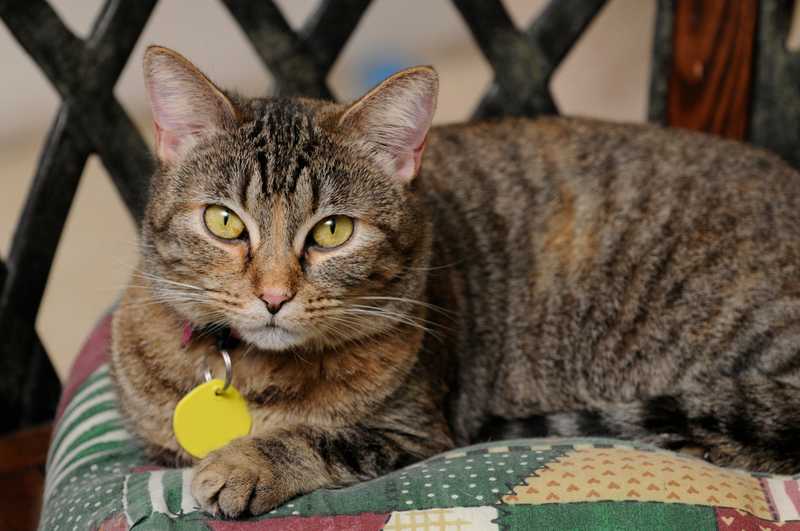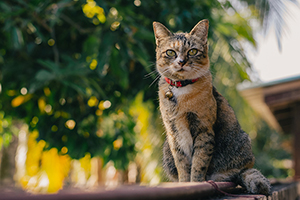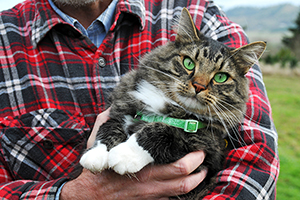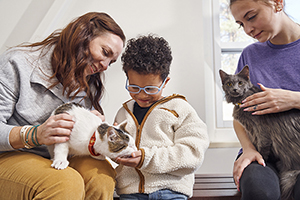Should Your Cat Wear a Collar and Tag?

Do cats have to have collars? Placing identification on our pets is a basic task for a pet guardian. Yet so many well-loved pets become lost without a collar and an identification tag to bring them safely home. Cat collars—with identification—are your cat’s fastest ticket back to you should they become lost.
The Importance of Cat Identification
Should cats wear collars? Do cats need a collar? Yes, because cat identification is an important part of cat care. According to the National Council on Pet Population Study and Policy, fewer than 2% of lost cats are ever returned to their guardians.
Just because your pet lives inside is not a guarantee of safety. Ohio Veterinary Medical Association Past President Dr. Linda Lord, DVM, reported that 40% of lost cats in one community were indoor-only cats and only 19% of cats reported lost had any sort of identification.
Common Cat Collar Safety Concerns
A collar and identification tag are the simplest and most economical ways to ensure your lost pet finds a way back to you. Still, many pet parents delay or resist adding identification to their pets. We can help you with some of the most common concerns.
I Worry That My Cat May Get Hung up on a Collar
There are several ways to prevent this, including:
- A well-fitted breakaway collar
- Not attaching a leash to your pet’s collar
If you’re wondering how to put a cat collar on, remember that a well-fitted collar (in general, allowing two fingers side-by-side to fit between the pet’s neck and the collar) is less likely to hang loosely, reducing the chance of something sliding underneath it. With cats, a well-fitted collar also eliminates the possibility of the cat grabbing the collar in their jaw or slipping a leg through a hanging loop.

Also, look for a breakaway cat collar. These collars are sturdy but will helpfully unclasp or break if the cat is caught and struggles. Buckle collars are not recommended.
Last, but not least, when walking on a leash, all cats should have their leash attached to a properly fitted harness rather than their ID collar.
But, That Noise!

Some people find the constant jingling of multiple tags (ID tag, rabies tag, license tag) distracting inside the home. Jingling tags can be quieted in a variety of simple ways:
- Brass nameplates can be riveted directly to the cat’s collar.
- “Tag silencers” are made of soft, flexible plastic and fit around the outside of the tag. You can even laminate the tag on both sides with regular clear household tape (although this will need to be peeled off and replaced as it wears out).
- A collar can be purchased with your cat’s name and phone number embroidered directly upon it.
- Depending on the type of collar your cat wears, you may be able to write your phone number directly on the collar with a black permanent marker.
Are flea collars safe for cats? Possibly, but ensuring you purchase a reputable brand is important, and a flea collar may not be the most appropriate option for your cat. You should always discuss flea control with your veterinarian.
What if My Cat Won’t Wear a Collar?
Can cats wear collars? Yes. But should cats wear collars, even if they don’t take to it right away? Introducing your cat gradually to anything new, including a collar, is essential. Here are a few steps on how to get a cat used to a collar:
- Start with just the collar and no add-ons, especially ones that could produce startling noises.
- Place the properly fitted collar on your cat for 10 minutes or, if the cat does not appear to object, for a few supervised hours.
- Reward the cat with a treat and playtime and remove the collar.
- Replace and remove the collar multiple times over a few days until your cat is comfortable and associates wearing the collar with great things like a fun time with you!
- Repeat the process after adding identification and rabies vaccination tags.
A cat who has never worn a collar should not be left unsupervised until you are sure they have accepted it. A positive introduction to a collar will make your cat far more comfortable wearing one permanently. If your cat doesn’t mind the collar but the tags cause some distraction, consider using a nameplate that is riveted to the collar or a collar embroidered with your current phone number.
Remember, Cats Grow, and Their Collars Must Grow with Them
Young cats will outgrow their “childhood” collars. Can kittens wear collars? Yes, but then you must remember that adult cats can gain or lose weight, which will alter the fit of their collar.
So, how tight should a cat collar be? When playing with or grooming your cat, always slide two fingers between the collar and your cat’s neck to verify it is adjusted properly.
How to Choose the Right Cat Collar and Tag/Types of Collars
Choosing how cats should wear collars and tags mostly comes down to personal preference. Collars come in materials like nylon or leather and recommended features like breakaway buckles help prevent entanglement and related injuries. GPS, reflective, harnesses and flea collars may also be good choices, depending on your cat’s needs and your preferences. Are there electric noise collars for cats? Yes, they exist, but they may have potential safety concerns.

Recommendations for information to place on cat collars and tags include basic information such as the pet’s name, your phone number and city of residence. Depending on your cat’s medical needs, other tags should be worn, such as rabies vaccination tags, license tags and medical alert tags.
Throughout reading this article, you may have also been thinking about cats and e-collars, otherwise known as an Elizabethan collar, or also a “cone of shame.” Or now you may be wondering, “What is an e-collar for cats?”
The kitten and cat collars known as “e-collars” protect cats from chewing, licking, pawing or scratching at wounds and after surgeries. These should not be used as everyday collars for your cat unless your veterinarian has told you otherwise.
Other Forms of Cat Identification
Microchipping
A microchip is a permanent ID that lasts the cat’s lifetime. The microchip is about the size of a grain of rice and is injected beneath the cat’s skin between the shoulder blades. The microchipping process is like a routine vaccination; anesthetic is not required. Microchips are read by passing a microchip scanner over the cat’s shoulder blades and body (in case the chip has migrated from the original site). The scanner emits a low radio frequency that reads the microchip’s unique code, identifying the cat.
According to one study at Ohio State University, microchipped cats were 20 times more likely to be returned to their guardians when compared to the general population of stray cats that had entered the shelters surveyed in the study.
It is essential to keep the cat owner’s contact information updated. When a cat is adopted from a shelter or adoption group or transferred to a new home, the new owner should immediately update the microchip information. When the owner moves or changes a phone number, this must also be reported to the microchip company. While many shelters will make a valiant effort to track down an owner when the microchip information is out-of-date, this takes valuable time and may prove impossible. Keep that microchip info current!
Even with a microchip, a collar and an ID tag will get a cat home the fastest. Not many of your nearest neighbors have a microchip scanner in their back pocket! The microchip is an excellent backup if a collar should become lost.
Do it for Your Pet’s Safety
Should cats wear collars? Yes. Research shows that ID tags play an important role in bringing cats home. Just as we carry identification in our wallets to help us navigate our human lives, our pets deserve the same safeguard with safety cat collars. Your homework today: Check your pet! Does your pet have a collar, and is it safely fitted? Are they carrying their identification to bring themselves safely home?
Spread the word! Share this article to help answer your friends should they ask, “Do cats need to wear a collar?”
If a friend or family member’s pet does not wear an ID, consider giving them a collar and tag as a present. Offer to pay for a microchip at their veterinarian for their birthday or any special holiday!
For more expert tips on adopting cats, explore our other cat adoption articles.